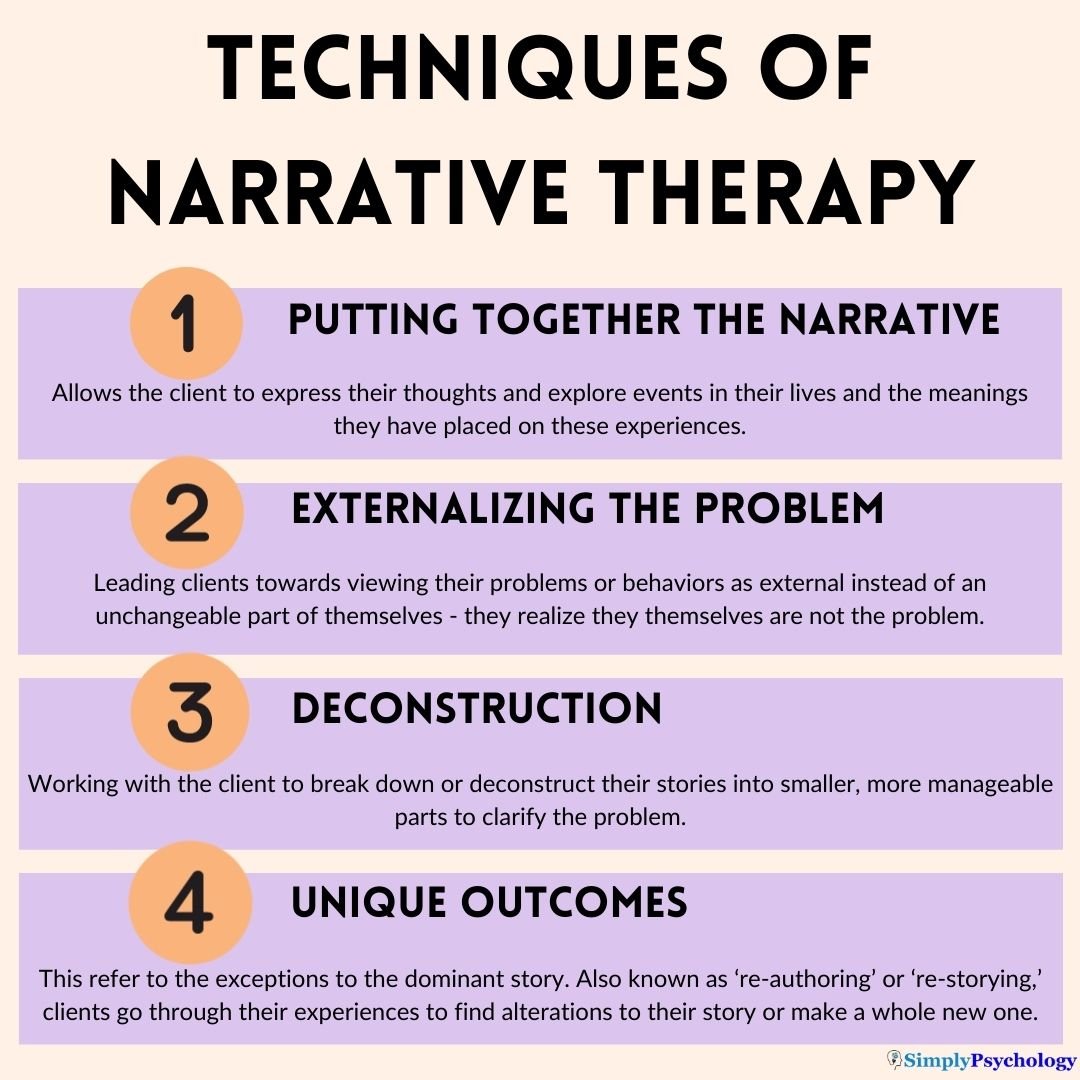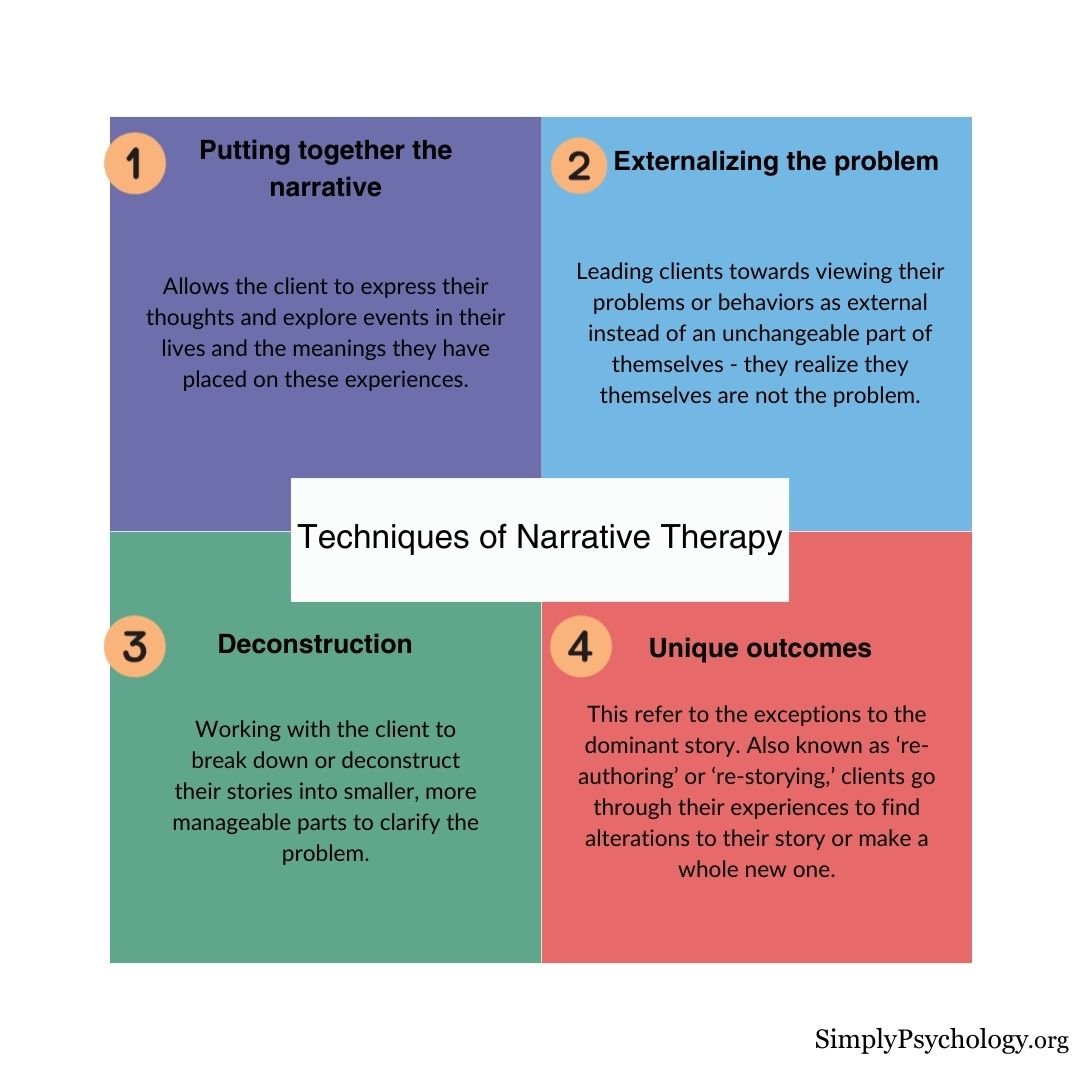Narrative therapy, is a powerful psychotherapeutic approach that empowers clients to explore and reshape their life stories, particularly those overwhelmed by challenges and emotional distress.
During sessions, clients engage in open dialogues with their therapists, delving into their narratives and actively challenging the ones that contribute to their struggles.
By separating problems from personal identity, narrative therapy emphasizes the belief that individuals are the ultimate authorities in their own lives.
Through this collaborative process, clients gain a deep understanding of their values and skills, enabling them to effectively confront present and future issues and pave the way for transformative change.
When was narrative therapy developed?
Narrative therapy was developed in the 1980s by therapists Michael White and David Epston. It is still a relatively novel approach to therapy that seeks to have an empowering effect and offer therapy that is non-blaming and non-pathological in nature.

What is a narrative?
A narrative is a story. As humans, we have many stories about ourselves, others, our abilities, our self-esteem, and our work, among many others.
How we have developed these stories is determined by how we have linked certain events together in a sequence and by the meaning attributed to them.
We like to interpret daily experiences in life, seeking to make them meaningful. The stories we have about our lives are created through linking certain events together in a particular sequence across a period of time and finding ways of making sense of them – this meaning forms the plot of the story.
As more and more events are selected and gathered into the dominant plot, the story gains richness and thickness.
The idea is that identity is formed by an individual’s life narrative, and several narratives are at work at once. The interpretation of a narrative can influence thinking, feelings, and behavior.
Many narratives are useful and healthy, whereas others can result in mental distress. Mental health symptoms can come about when there is an unhealthy or negative narrative or if there is a misunderstanding or misinterpretation of a narrative.
What is the aim of narrative therapy?
Narrative therapy seeks to change a problematic narrative into a more productive or healthier one. This is often done by assigning the person the role of narrator in their own story.
Narrative therapy helps to separate the person from the problem and empowers the person to rely on their own skills to minimize problems that exist in their lives.
This therapy aims to teach the person to view alternative stories and address their issues in a more productive way.
Narrative therapy can be used with individuals but can also prove useful for couples or families.
Narrative therapists are also not interested in diagnosing individuals – there is no use of the Diagnostic and Statistical Manual of Mental Disorders (DSM) during any point of the therapy.
What is the role of the therapist?
The role of the narrative therapist is to search for an alternative way of understanding a client’s narrative or an alternative way to describe it.
The belief is that telling a story is a form of action toward change. Therefore, the therapist will help clients to objectify their problems, frame these problems within a larger sociocultural context, and teach the person how to make room for other stories.
During therapy, the therapist acts as a non-directive collaborator. They treat the client as the expert on their own problems and do not impose judgments.
Instead, the therapist is purely curious and investigative. They are not particularly interested in the cause of a problem but are open to a client’s perception of the cause.
Narrative Therapy Techniques

Putting together the narrative
The therapists help their clients to put together their narratives. This will usually involve listening to the client explain their stories and any issues that they want to bring up.
This allows the person to express their thoughts and explore events in their lives and the meanings they have placed on these experiences.
The therapist may find what is known as a ‘problem-saturated narrative’ comes up, which will be what is causing the client the most distress.
As the story comes together, the client becomes an observer of their story and can then review this with the therapist.
When the therapist communicates to the client during this stage, they will make sure to utilize the client’s use of language since the client is treated as the expert in their narrative.
Externalizing the problem
Once the story is put together, the idea is that it allows the client to observe themselves. The therapist encourages the client to create distance between the individual and their problems, called externalization.
The externalization techniques lead clients towards viewing their problems or behaviors as external instead of an unchangeable part of themselves.
The therapist may ask the client to give a name to the problem so it is seen as a separate entity, such as ‘anger’ or ‘worry.’ The client will then be encouraged to use the given name of the problem when talking about it. Likewise, the therapist will ask questions referring to the problem by the given name.
The distance given to the problem allows people to focus on changing unwanted behaviors.
As people practice externalization, they will see that they can change. The general idea is that it is easier to change a behavior that they do than to change a core personality characteristic.
They will realize that they themselves are not the problem; instead, the problem is the problem.
Deconstruction
Often, when a client has a problematic story, especially when it has been prevalent for a long time, the problem can feel overwhelming, confusing, or unsolvable.
Because of these feelings, people can use overgeneralized statements which can make the problematic stories worse.
The narrative therapist would work with the individual to break down or deconstruct their stories into smaller, more manageable parts to clarify the problem.
Deconstructing makes the problems more specific and reduces overgeneralizing; it also clarifies what the core issue or issues may be. Through deconstructing, the whole picture becomes easier to understand.
The therapist and client may also seek to deconstruct identity and have an awareness of larger societal issues, e.g., sociocultural and political effects which may be acting on the client.
They may find that the context of gender, class, race, culture, and sexual identity also play a part in the interpretations and meanings given to events.
Unique outcomes
When someone’s problematic stories are well established, people can become stuck in them, unable to view alternative versions of the story. A narrative therapist will help people challenge their stories and encourage them to consider alternative stories.
Unique outcomes refer to the exceptions to the dominant story. It may also be known as ‘re-authoring’ or ‘re-storying,’ as clients go through their experiences to find alterations to their story or make a whole new one.
There are hundreds of different stories since everyone interprets experiences differently and finds their own meaning from them. The therapist will help the client to build upon an alternative or preferred story.
These unique outcomes contrast a problem, reflect a person’s true nature, and allow someone to rewrite their story.
Building upon stories from another perspective can help to overcome problems and build the confidence the person needs to heal from them.
Benefits of narrative therapy
Empowers the individual
As this therapy stresses that people do not label themselves negatively (e.g., as the problem), this can help them feel less powerless in distressing situations.
They find that they have more control over the stories they have in their lives and how they approach difficult events.
Supportive
Narrative therapy treats individuals with respect and supports the bravery it has taken for them to choose to work through their personal challenges.
Non-confrontational
This is a non-judgmental approach to therapy, meaning that the clients are not blamed for anything described in their stories.
Likewise, the clients are encouraged not to blame others or themselves. The focus is instead placed on noticing and changing unhelpful stories about themselves and others.
The client is treated as an expert
Narrative therapy does not aim to change a person; rather, it allows them to become an expert in their own lives.
The therapist holds that the clients know themselves well and work as collaborative partners with the client.
This therapy allows people to not only find their voice but to use this voice for good, enabling them to become experts and live in a way that reflects their goals and values.
Context is considered
This therapy may also help the client view their problems differently. These can be social, political, and cultural, among others.
The clients recognize that these contexts matter and can influence how they view themselves and their stories.
What can narrative therapy help with?
Narrative therapy may help treat the symptoms of a variety of conditions, including:
-
Depressive disorders
-
Attention deficit hyperactivity disorder (ADHD)
-
Posttraumatic stress disorder (PTSD)
As well as mental health conditions, narrative therapy may also be useful for the following:
-
Those who feel like they are overwhelmed by negative experiences, thoughts, or emotions.
-
Those with attachment issues.
-
Those who are suffering from grief.
-
Those who have issues with low self-esteem.
-
Those who often feel powerless in many situations.
How is narrative therapy used?
For individuals, narrative therapy challenges the dominant problematic stories that prevent people from living their best lives.
Through the externalizing technique, people can learn to separate themselves from the problem.
They learn to identify alternative stories, widen their views of themselves, challenge old and unhealthy beliefs, and be open to new ways of living that reflect a more accurate and healthier story.
For couples or families, externalizing problems can facilitate positive interaction.
It can also make negative communication more accepting and meaningful. Seeing problems objectively can help couples and families reconnect and strengthen their relationships.
Once problems have been identified, this can be used to address how the problem has challenged the core strength of their bond.
How effective is narrative therapy?
Below are some of the studies which have investigated the effectiveness of narrative therapy:
-
A research study looked at evaluating the effectiveness of narrative therapy in increasing couples’ intimacy and its dimensions.
The results showed that this therapy significantly increased intimacy and on three dimensions of emotional, communication, and general intimacy, concluding that narrative therapy can provide valuable implications for the mental health of couples (Khodabakhsh et al., 2015).
-
Research has found that married women experienced increased levels of marital satisfaction after being treated with narrative therapy (Ghavibazou et al., 2020).
-
A study of adults with depression and anxiety looked at the effects of narrative therapy and found improvements in their self-reports of quality of life, and they had decreased symptoms of anxiety and depression (Shakeri et al., 2020).
-
A small sample pilot study aimed to determine whether narrative therapy was effective in helping young people with Autism who present with emotional and behavioral difficulties.
It was found that there were significant improvements in psychological distress and emotional symptoms (Cashin et al., 2013).
-
A study looked at the effectiveness of narrative therapy in boosting 8-10-year old’s social and emotional skills. The results showed that the children showed significant improvements in self-awareness, self-management, empathy, and responsible decision-making (Beaudoin et al., 2016).
-
A study explored group narrative therapy for improving the school behavior of a small sample of girls with attention deficit hyperactivity disorder (ADHD).
Posttreatment ratings by teachers showed that there was a significant effect on reducing ADHD symptoms one week after completing the therapy sessions, and this was sustained after 30 days (Looyeh et al., 2012).
Limitations
One of the major limitations of narrative therapy is that research into its effectiveness is still lacking.
Further research is also needed to determine what mental health conditions narrative therapy might treat most effectively.
A reason for the lack of research is that it is still a relatively new approach to therapy. Another reason could be due to it being difficult to quantify.
The view that narrative therapists have is that knowledge is subjective and constructed by each person.
They accept there is no universal truth, so some narrative therapists make the argument that this therapy should be studied qualitatively rather than quantitatively.
How to get started
Narrative therapy is a specialized approach to counseling with training opportunities for therapists to learn how to use this approach with clients.
Finding the right therapist can involve looking online through therapist directories. Alternatively, you may consider asking your doctor to refer you to a professional in your area with the right training and experience.
It is important to choose the right therapist for you. Consider whether you feel comfortable discussing personal information with them. Don’t be afraid to seek a different therapist if the one you have does not quite suit your needs.
When choosing a therapist, consider thinking about what your deal breakers are, important qualities, and any other characteristics you value.
What questions can you ask yourself when considering therapy?
When you are ready to select a therapist, think about the following:
1. What type of therapy do you want? – Do you want individual, couples, family therapy, or another type?
2. What are your main goals for therapy?
3. Whether you can commit the time each week – what days and times are most convenient for you?
What can be expected during the first therapy session?
During the first narrative therapy session, the therapist may ask you to begin sharing your story, and they may ask questions about why you are seeking treatment.
The therapist may also want to know about how your problems are affecting your life and what your goals for the future are.
Furthermore, they are likely to discuss aspects of treatment, such as how often you will meet and how your treatment may change from one session to the next.
What are some considerations for narrative therapy?
This therapy can be very in-depth, exploring a wide range of factors that can influence the development of your stories.
It also involves talking about problems as well as strengths which may be difficult for some people.
The therapist will help you to explore your dominant story in-depth and discover how it may be contributing to emotional distress, as well as uncover strengths that can help you to approach your problems differently.
You should expect to re-evaluate your judgments about yourself since narrative therapy encourages you to challenge and reassess these thoughts and replace them with more realistic or positive ones.
It also challenges you to separate yourself from your problems which can be difficult, but this process helps you learn to give yourself credit for making the right decisions for you.
Do you need mental health help?
USA
Contact the National Suicide Prevention Lifeline for support and assistance from a trained counselor. If you or a loved one are in immediate danger: https://suicidepreventionlifeline.org/
1-800-273-8255
UK
Contact the Samaritans for support and assistance from a trained counselor: https://www.samaritans.org/; email jo@samaritans.org .
Available 24 hours a day, 365 days a year (this number is FREE to call):
116-123
Rethink Mental Illness: rethink.org
0300 5000 927
Further Information
Morgan, A. (2000). What is narrative therapy? (p. 116). Adelaide: Dulwich Centre Publications.
References
Beaudoin, M. N., Moersch, M., & Evare, B. S. (2016). The effectiveness of narrative therapy with children’s social and emotional skill development: an empirical study of 813 problem-solving stories. Journal of Systemic Therapies, 35(3), 42-59.
Cashin, A., Browne, G., Bradbury, J., & Mulder, A. (2013). The effectiveness of narrative therapy with young people with autism. Journal of Child and Adolescent Psychiatric Nursing, 26(1), 32-41.
Ghavibazou, E., Hosseinian, S., & Abdollahi, A. (2020). Effectiveness of narrative therapy on communication patterns for women experiencing low marital satisfaction. Australian and New Zealand Journal of Family Therapy, 41(2), 195-207.
Khodabakhsh, M. R., Kiani, F., Noori Tirtashi, E., & Khastwo Hashjin, H. (2015). The effectiveness of narrative therapy on increasing couples intimacy and its dimensions: Implication for treatment. Family Counseling and Psychotherapy, 4(4), 607-632.
Looyeh, M. Y., Kamali, K., & Shafieian, R. (2012). An exploratory study of the effectiveness of group narrative therapy on the school behavior of girls with attention-deficit/hyperactivity symptoms. Archives of Psychiatric Nursing, 26(5), 404-410.
Shakeri, J., Ahmadi, S. M., Maleki, F., Hesami, M. R., Moghadam, A. P., Ahmadzade, A., Shirzadi, M. & Elahi, A. (2020). Effectiveness of group narrative therapy on depression, quality of life, and anxiety in people with amphetamine addiction: a randomized clinical trial. Iranian Journal of Medical Sciences, 45(2), 91.


